Product Safety - Rear Brake Line Routing

| Subject: | 04086 -- Rear Brake Lining Routing |
| Models: | 2004-2005 Cadillac XLR |
| 2005 Chevrolet Corvette |
Condition
General Motors has decided that a defect, which relates to motor vehicle safety, exists in certain 2004 and 2005 model year Cadillac XLR vehicles, and 2005 model year Chevrolet Corvette vehicles. The rear brake lines may contact other components or be affected by heat from them.
If contact occurs, the driver may hear a rattle noise. Over time, the contact could cause brake line wear-through resulting in a slow loss of brake fluid, which would appear as fluid spotting under the vehicle. On XLR vehicles, this could also create a visible puff of smoke when the brakes are applied. If enough fluid is lost, the performance of the rear brakes will be reduced, there would be an increase in brake pedal effort in order to achieve the desired braking, and the brake system warning light may illuminate on the instrument panel.
If the brake line on XLR vehicles is affected by heat, the fluid in the brake line could boil. The performance of the rear brakes will be reduced and there would be an increase in brake pedal effort in order to achieve the desired braking.
If this were to occur when stopping distance is limited, a crash could occur.
Correction
Dealers are to inspect, and reposition or secure if necessary, the rear brake lines to ensure that there is adequate clearance from other underbody components. On some vehicles, a machining tab on the rear differential housing may need to be removed to provide adequate clearance. The rear brake lines are to also be inspected and, if damaged, repaired.
Vehicles Involved
Involved are certain 2004 and 2005 model year Cadillac XLR vehicles, and 2005 model year Chevrolet Corvette vehicles built within these VIN breakpoints:
Year | Division | Model | From | Through |
|---|---|---|---|---|
2004 | Cadillac | XLR | 45600001 | 45604352 |
2005 | Cadillac | XLR | 55600001 | 55600581 |
2005 | Chevrolet | Corvette | 55100321 | 55101325 |
Important: Dealers should confirm vehicle eligibility through GMVIS (GM Vehicle Inquiry System) before beginning recall repairs. [Not all vehicles within the above breakpoints may be involved.]
For US
For dealers with involved vehicles, a Campaign Initiation Detail Report containing the complete Vehicle Identification Number, customer name and address data has been prepared and will be loaded to the GM DealerWorld, Recall Information website. Dealers that have no involved vehicles currently assigned, will not have a report available in GM DealerWorld.
For Canada
For dealers with involved vehicles, a Campaign Initiation Detail Report containing the complete Vehicle Identification Number, customer name and address data has been prepared, and is being furnished to involved dealers. Dealers that have no involved vehicles currently assigned, will not receive a Campaign Initiation Detail Report.
For Export
For dealers with involved vehicles, a Campaign Initiation Detail Report containing the complete Vehicle Identification Number, customer name and address data has been prepared, and is being furnished to involved dealers. Dealers that have no involved vehicles currently assigned, will not receive a report with the recall bulletin.
The Campaign Initiation Detail Report may contain customer names and addresses obtained from Motor Vehicle Registration Records. The use of such motor vehicle registration data for any purpose other than follow-up necessary to complete this recall is a violation of law in several states/provinces/countries. Accordingly, you are urged to limit the use of this report to the follow-up necessary to complete this recall.
Parts Information
Parts required to complete this recall are to be obtained from General Motors Service Parts Operations (GMSPO). Please refer to your "involved vehicles listing" before ordering parts. Normal orders should be placed on a DRO=Daily Replenishment Order. In an emergency situation, parts should be ordered on a CSO=Customer Special Order.
Important: It is anticipated that very few vehicles will require brake pipe replacement. Dealers are encouraged not to order recall parts for use as shelf stock. Parts should only be ordered when inspection determines that it is necessary to replace the brake pipe assembly.
Part Number | Description | Qty |
|---|---|---|
25649654 | Cover (XLR) (services 4 vehicles) | 1 |
88965635 | Pipe, RR Brk Frt (XLR) | 1 (If Req'd) |
88965636 | Pipe, RR Brk RR (XLR) | 1 (If Req'd) |
15262861 | Pipe Asm, RR Brk C/Over (XLR & Corvette) | 1 (If Req'd) |
12377967 (US) 89021320 (Canada) | Fluid, Hy Brk | 1 (If Req'd) |
Service Procedure
The following procedure provides instructions for inspecting, and if necessary, replacing the hydraulic brake fluid pipes that go to the rear brakes at THREE different locations on the Cadillac XLR and ONE location on the Chevrolet Corvette.
| • | On the XLR, two of the locations are on the long pipes that go from the ABS module in the engine compartment, along the left frame rail and driveline tunnel to the rear frame (cradle). The third location is the crossover pipe that goes across the rear cradle from the left side of the vehicle to the right side. |
| • | On the Corvette, the only location is the crossover pipe that goes across the rear cradle from the left side of the vehicle to the right side. |
Inspection
Front Brake Pipe Inspection - Cadillac XLR Only
- Raise the vehicle on a suitable hoist and support as necessary.
- In the front of the vehicle, locate the two REAR brake pipes in the area of the left exhaust manifold and converter assembly (3). The two pipes will be running along the inside of the frame rail and are wrapped in a silver heat resistant material (1). In between the two sections of the heat resistant material is a plastic retaining clip (2). This clip should be attached to a stud located on the frame rail.
- Reposition the retaining clip as necessary and install it on the stud located on the frame rail. Press firmly into place.
- Remove any dirt or foreign material from the frame rail in the area of the plastic retainer.
- Trim a piece of adhesive cover (P/N 25649654) to a size of approximately 100 mm by 125 mm (4 in by 5 in).
- Remove the backing material from the adhesive cover and apply the material (1) over the retaining clip and brake pipes and press firmly to the frame rail.
- Proceed to the section titled, "Rear Brake Pipe Inspection".
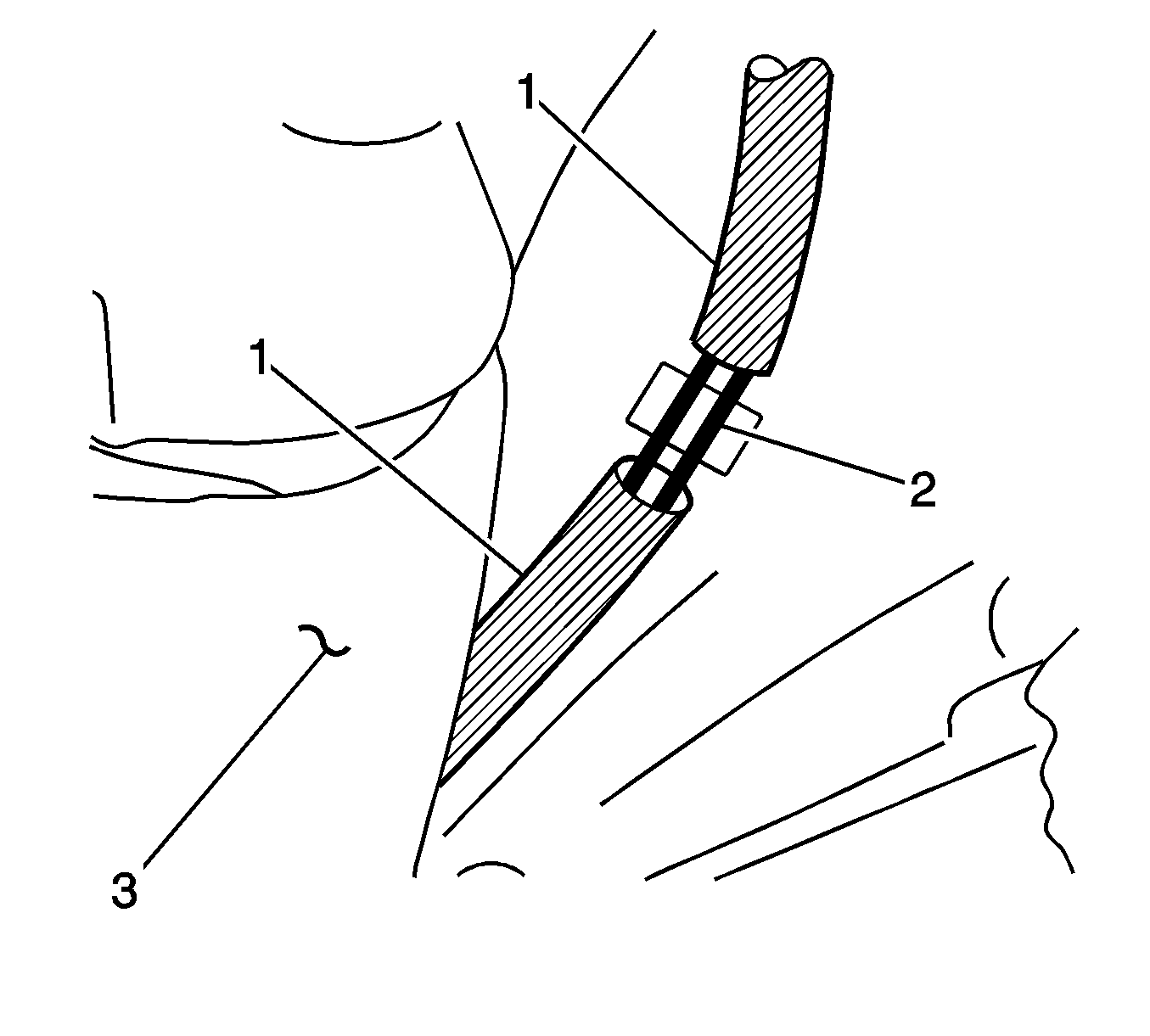
| • | If the retaining clip IS attached to the frame rail, no further inspection is needed in this area of the vehicle. Proceed to Step 4 in this section. |
| • | If the retaining clip is NOT attached to the frame rail, inspect to see if the pipes (and heat resistant material) are, or have been contacting the exhaust manifold and converter assembly. If there IS evidence of contact and the black coating on the pipe(s) is worn through (you can see the bare steel) then the front section of brake pipes must be replaced. Before replacing the pipes, continue onto the section titled, "Rear Brake Pipe Inspection". |
| • | If the bare steel CANNOT be seen, then proceed to the next step. |
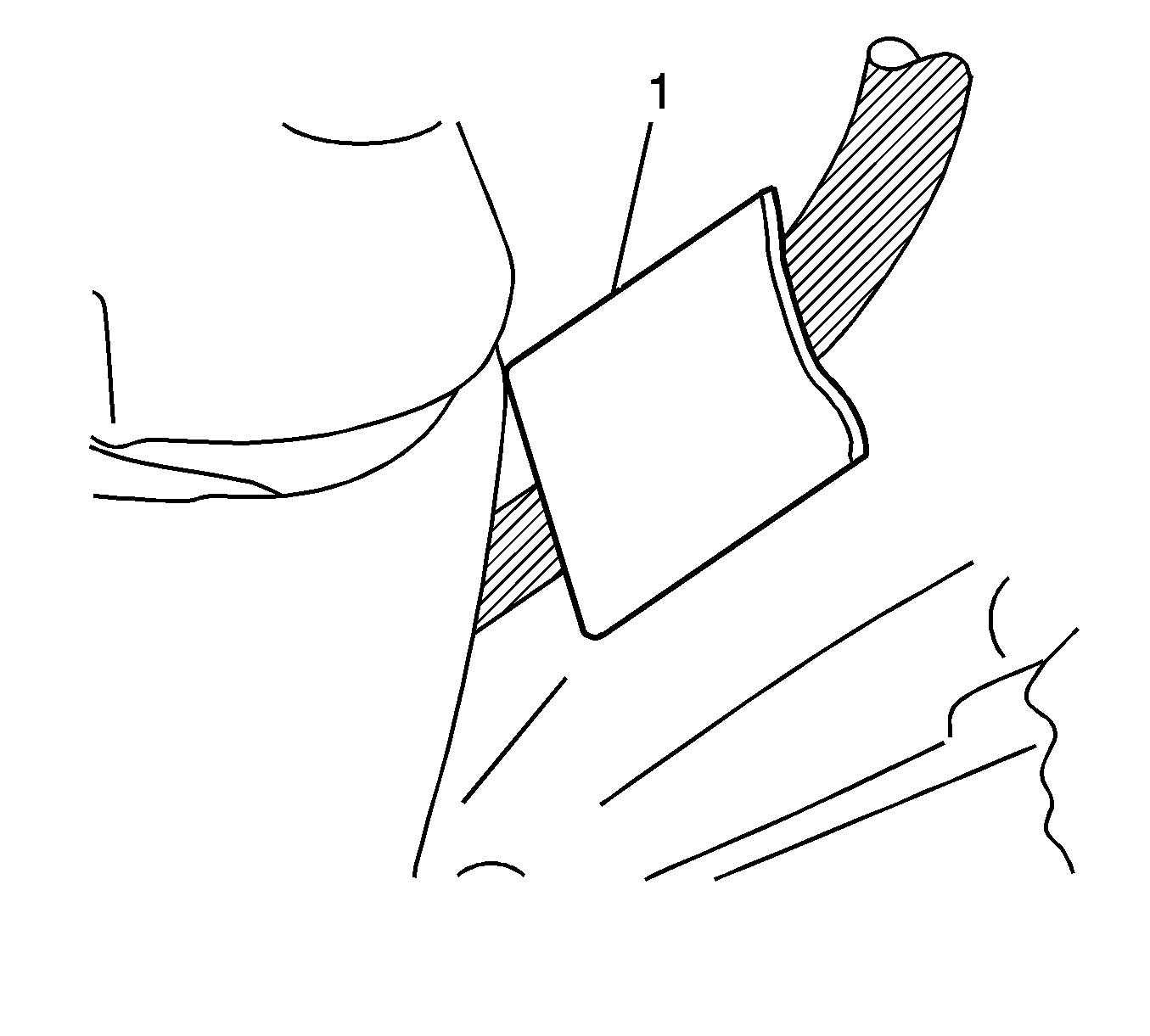
Rear Brake Pipe Inspection - Cadillac XLR Only
- Towards the rear of the vehicle where the left exhaust pipe (1) bends upward to go over the drive axle, locate the two rear brake pipes (2). The two pipes will be running along the left inside of the driveline tunnel. They DO NOT have any heat resistant material.
- Once the brake pipes have been located, inspect for clearance to the left exhaust pipe (1) in the area just forward of where the brake pipes (2) bend downward to connect to the crossover and left rear flexible hose.

| • | If the clearance (space) between each brake pipe and the exhaust pipe is 40 mm (1.5 in) or more, no further inspection or repair is needed in this area of the vehicle. Proceed to the section titled, "Rear Brake Crossover Pipe Inspection". |
| • | If the clearance is LESS than 40 mm (1.5 in), but neither pipe is contacting the exhaust pipe, bend the pipe(s) as necessary to obtain the necessary clearance. Proceed to the section titled, "Rear Brake Crossover Pipe Inspection". |
| • | If the pipe(s) ARE contacting, or there IS evidence that the pipe(s) have been contacting the exhaust pipe, inspect to see if the black coating on the brake pipes is worn through (you can see bare steel). If the black coating has worn through, then the rear section of brake pipes must be replaced. Before replacing the pipes, continue on to the section titled, "Rear Brake Crossover Pipe Inspection". |
| • | If the bare steel CANNOT be seen, then bend the pipes as necessary to obtain the necessary clearance and proceed to the section titled, "Rear Brake Crossover Pipe Inspection". |
Rear Brake Crossover Pipe Inspection - Cadillac XLR and Chevrolet Corvette
- Locate the crossover pipe (1) in the rear frame (cradle) assembly. The pipe connects the rear brake pipe coming from the front of the vehicle to the flex hose going to the right rear brake caliper.
- Once the pipe has been located, inspect for contact to the rear cradle at the locations shown in the illustration. Also inspect for contact to the boss on the rear differential.
- Wrap several layers of heavy tape around one end of a hacksaw blade (1) to form a handle (2).
- Standing under the rear of the vehicle and facing towards the front, insert the hacksaw blade (1) between the bottom of the cradle and the top of the leaf spring so that it is in contact with the boss (2) on the differential. The teeth on the blade should be facing towards the right rear wheel.
- Carefully work the blade back and forth to cut off the boss (1).
- If any brake pipes require replacement, proceed to the appropriate brake pipe replacement procedure in this bulletin. If no brake pipes require replacement, no further action is required. Proceed to the next step.
- Lower the vehicle.
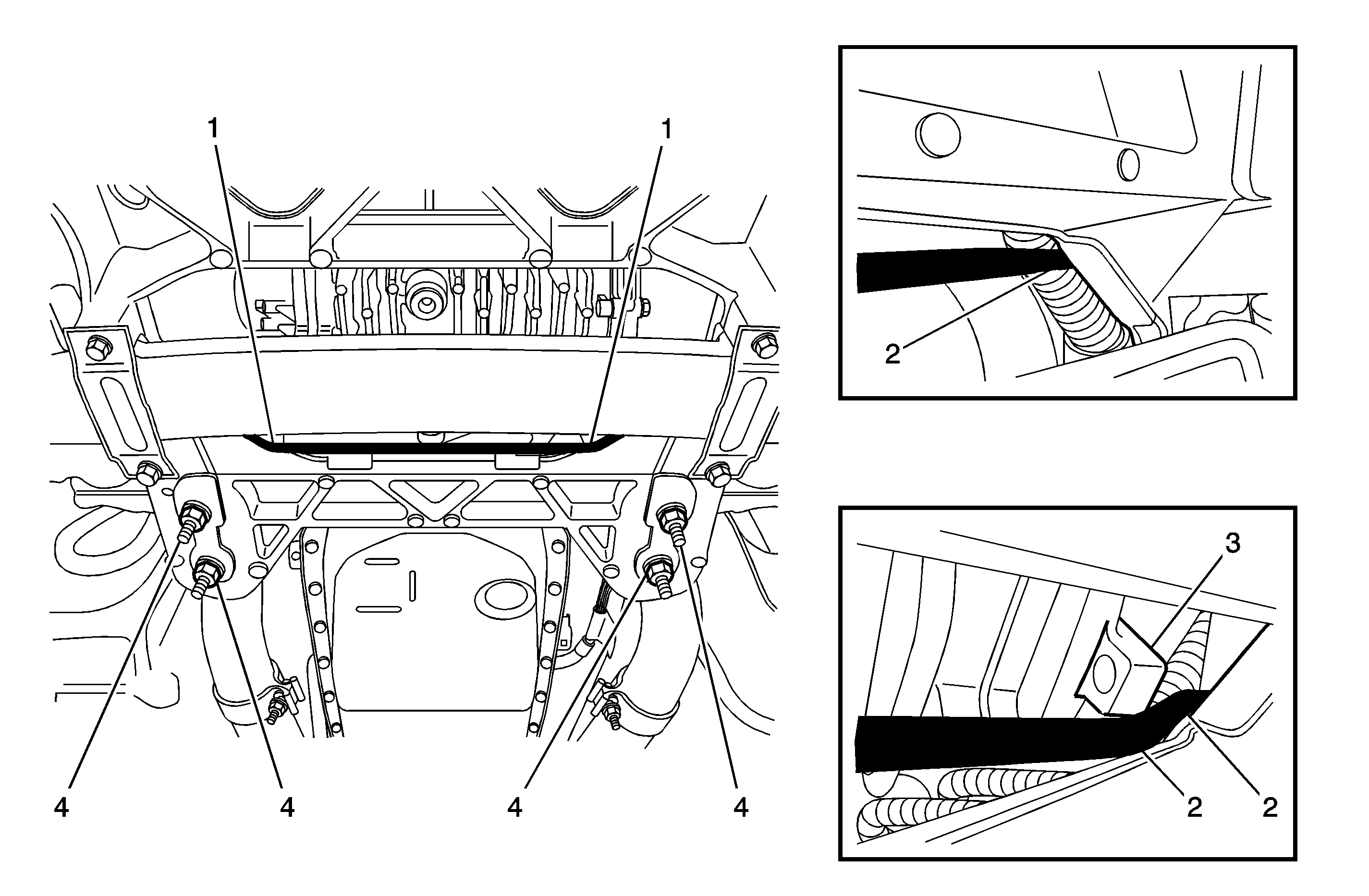
| • | If there is evidence of contact at any of the locations shown (2) and the black coating on the pipe IS worn through (you can see bare steel), then the crossover pipe must be replaced. Before replacing the pipe proceed to the next step for removal of the boss (3) on the differential. |
| • | If there is evidence of contact but the bare steel CANNOT be seen, then the crossover pipe does NOT need to be replaced. Bend the pipe as necessary to eliminate any contact points with the cradle. Proceed to the next step for removal of the boss (3) on the differential. |
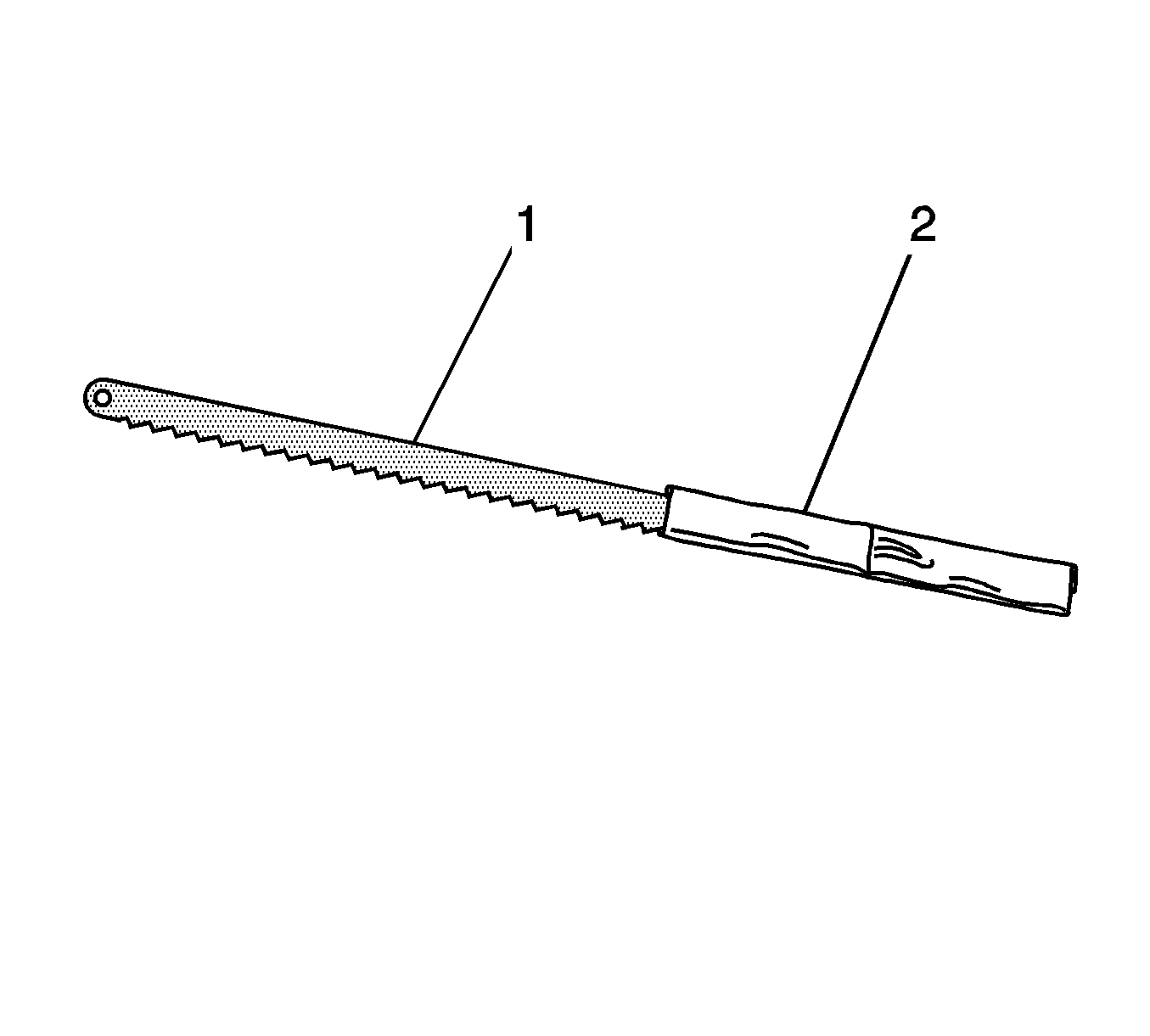
Important: Regardless of whether the crossover pipe is contacting the boss on the differential or not, the boss must be removed.
Important: Because the clearance is very limited, it will be necessary to use a hacksaw blade without the handle in the next step.
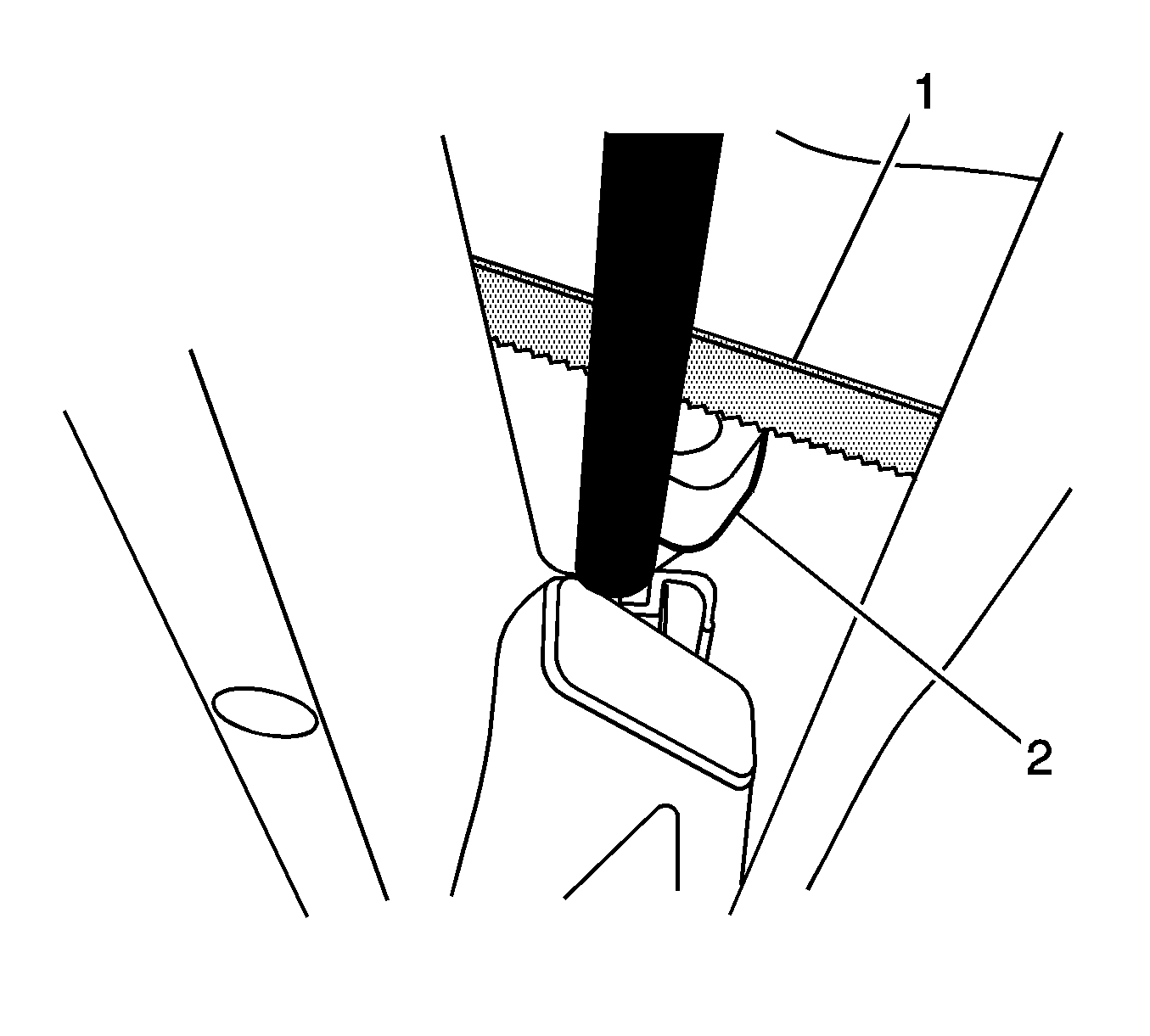
Notice: DO NOT use power tools for removing the boss because of the close proximity of the brake pipe.
Important: It is not necessary to cut off the boss flush with the differential case. It is acceptable to cut the boss off across or through the threaded hole.

Brake Pipe Replacement
Front Brake Pipe Replacement - Cadillac XLR Only
Tools Required
J 45405 Brake Pipe Flaring Kit
- Loosen and remove the nuts (2) from the studs attaching the exhaust pipes to the exhaust manifolds.
- Loosen the exhaust pipe to muffler band clamps (2, 5).
- Remove the exhaust pipe hanger lower bolts (3).
- Slide the mufflers out from the rear hangers (1).
- Separate the exhaust pipes from the mufflers.
- Remove the exhaust pipes and mufflers.
- Remove the thirty-six bolts that attach the driveline tunnel closeout panel to the underbody and remove the panel.
- Unclip the rear brake pipes from the retainers in the driveline tunnel.
- Using the tubing cutter contained in J 45405, Brake Pipe Flaring Kit, cut the two rear brake pipes off under the vehicle.
- Release the brake pipes going to the front of the vehicle from the retaining clips.
- Lower the vehicle.
- Open the hood.
- Remove the engine cover (sight shield).
- Partially drain the radiator.
- Remove the upper radiator hose from the radiator.
- Remove the bolts attaching the surge tank and reposition the tank so there is access to the top of the ABS modulator valve.
- Remove the two bolts attaching the lower intermediate shaft to the column.
- Remove the pinch bolt attaching the intermediate shaft to the steering gear.
- Slide the lower intermediate shaft from the column and remove the intermediate shaft.
- Disconnect the fittings for the two rear brake pipes from the ABS modulator valve.
- While noting the routing location, carefully remove the complete pipe assembly from the vehicle.
- Install the complete new pipe assembly into the vehicle following the same routing.
- Connect the fittings on the new pipes to the ABS modulator valve.
- Install the intermediate shaft and bolts.
- Reposition the surge tank and install the attaching fasteners.
- Connect the upper radiator hose to the radiator.
- Fill the cooling system.
- Install the engine cover.
- Raise the vehicle.
- Confirm the alignment of the new pipes to the existing rear pipes and cut the new pipes as necessary, taking into consideration the staggered cut made earlier on the rear pipes.
- INSTALL ONE FLARE NUT ON EACH PIPE and, following the instructions contained in J 45405, make all the necessary flares.
- Using the unions included with the new front pipes, align the pipes using the mark made earlier and connect the pipes to the rear pipes.
- Secure the brake pipes in the retainers.
- Remove any dirt or foreign material from the frame rail in the area of the plastic retainer that is located near the left engine exhaust manifold.
- Trim a piece of adhesive cover (P/N 25649654) to a size of approximately 100 mm by 125 mm (4 in by 5 in).
- Remove the backing material from the adhesive cover and apply the material (1) over the retaining clip and brake pipes and press firmly to the frame rail.
- Position the driveline tunnel closeout panel to the underbody and install the bolts.
- Position the mufflers over the rear axle.
- Connect the exhaust pipes to the mufflers and then to the converters.
- Connect the mufflers to the hangers.
- Install the exhaust pipe hanger lower bolts.
- Install the nuts on the converter studs.
- Position and install the exhaust pipe to muffler band clamps.
- Inspect for clearance to the left exhaust pipe in the area just forward of where the brake pipes bend downward to connect to the crossover and left rear flexible hose. The clearance should be 40 mm (1.5 in). Bend the pipe(s) as necessary to obtain the necessary clearance.
- Lower the vehicle.
- Bleed the brake system as necessary.
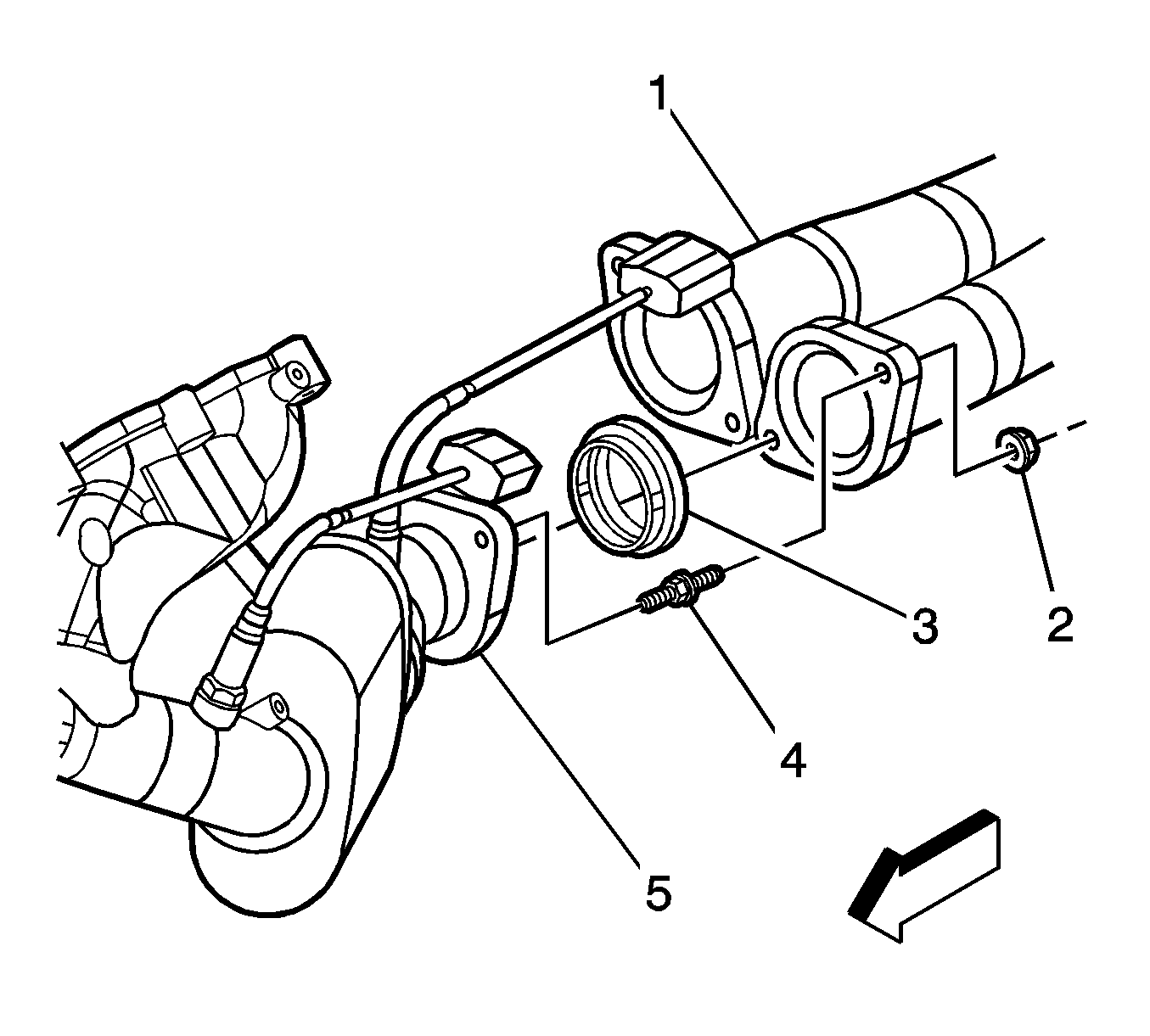
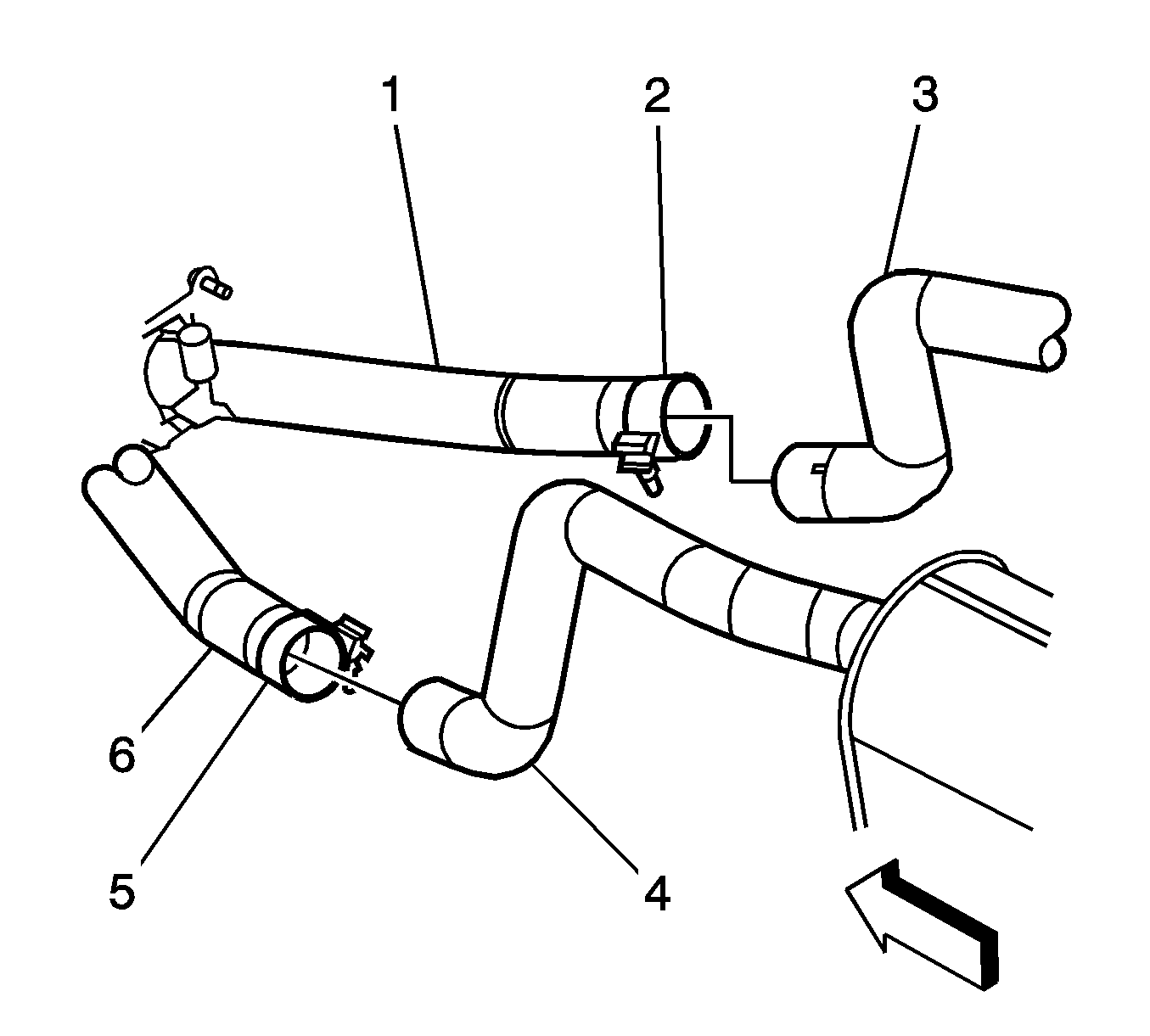

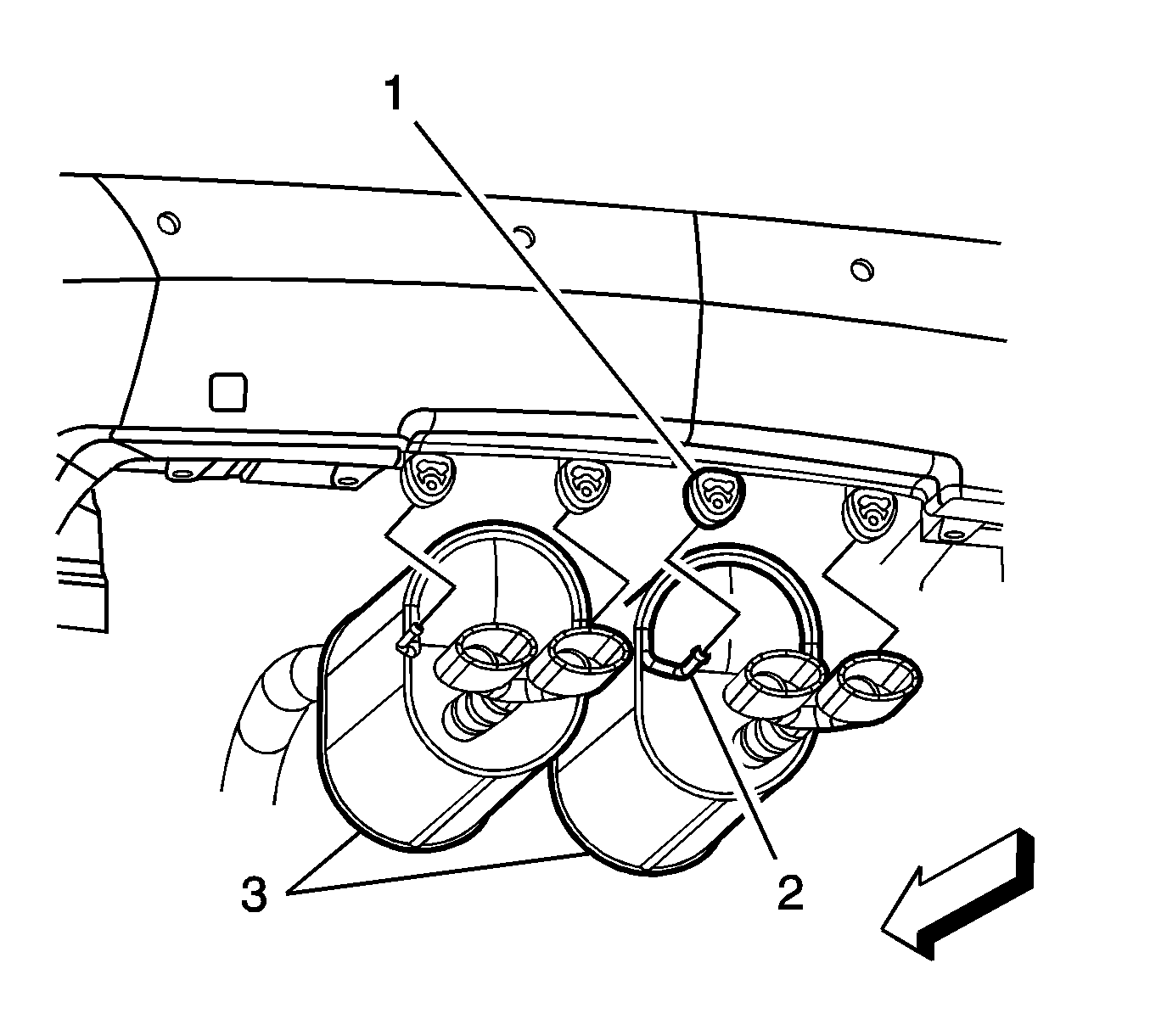


Important: When cutting off the brake pipes in the next steps, the cuts on the pipes should be staggered about 50 mm (2 in) from each other.
Important: Before cutting the pipes make a note or mark which pipe is the upper. This will be used when reassembling the pipes later in this procedure.
Important: Inspect the length of the new brake pipes to determine "approximately" where to cut the old pipes under the vehicle in the next step. DO NOT cut the pipes too short.
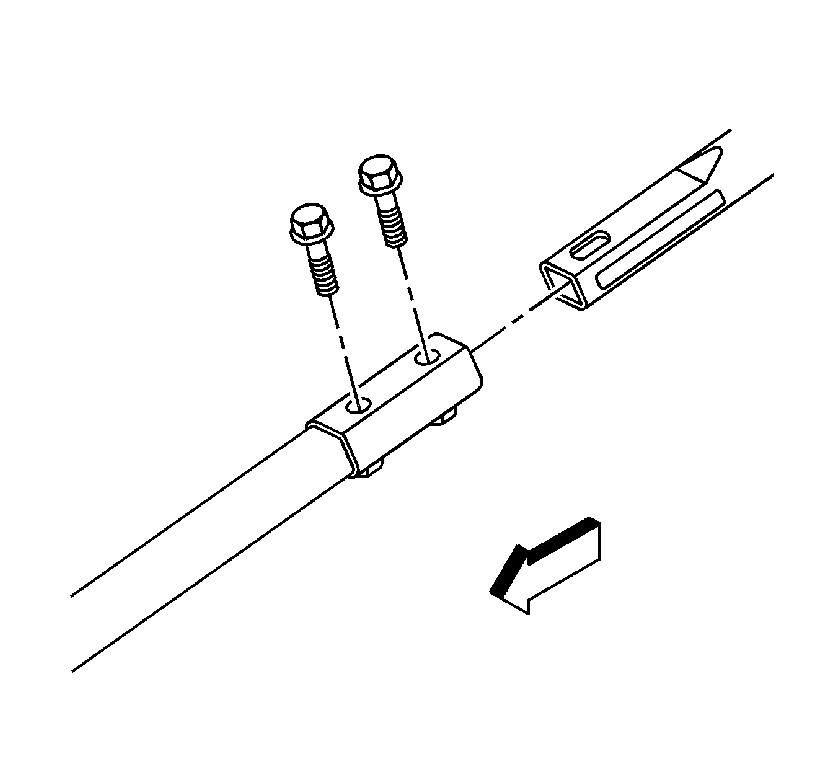
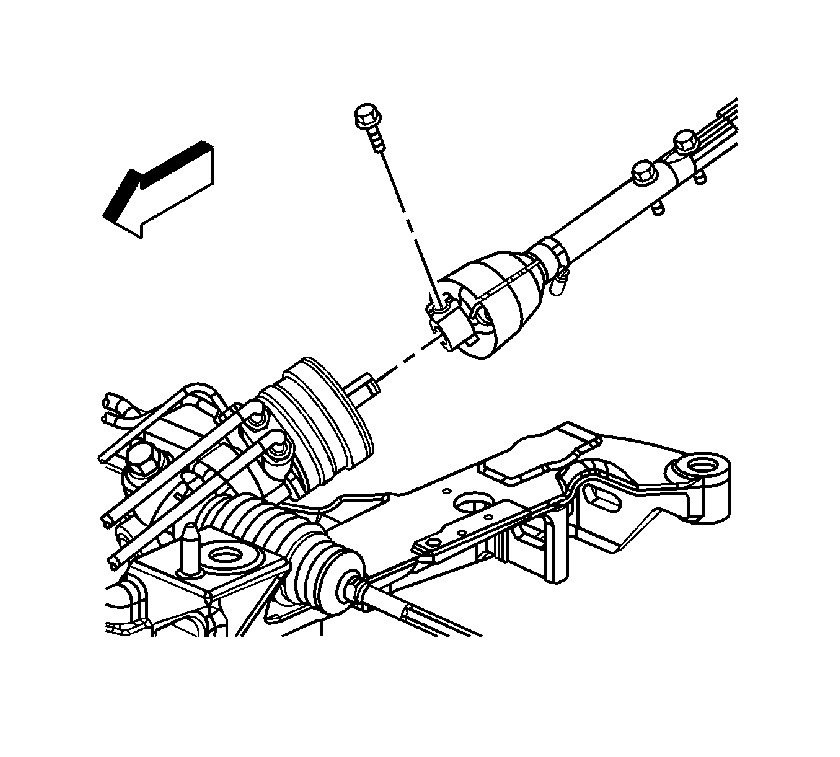
Important: When removing the brakes pipes in the next step, it will be necessary to rotate the assembly to clear various components. It is NOT necessary to bend the pipes.
Tighten
Tighten the fittings to 16 N·m(12 lb ft).
Tighten
| • | Tighten the lower pinch bolt to 34 N·m(25 lb ft). |
| • | Tighten the two upper bolts to 48 N·m(35 lb ft). |
Tighten
Tighten the attaching fasteners to 8 N·m(71
lb in).
Tighten
Tighten the fittings to 18 N·m(13 lb ft).

Important: When installing the bolts in the next step, the first bolt to be installed must go in the one ROUND locating hole in the panel. The remaining 35 bolts can then be installed in the SLOTTED holes.
Tighten
Tighten the bolts to 10 N·m(88 lb in).
Tighten
Tighten to 50 N·m(37 lb ft).
Tighten
Tighten to 20 N·m(15 lb ft).
Tighten
Tighten to 44 N·m(32 lb ft).
Rear Brake Pipe Replacement - Cadillac XLR Only
- Raise the vehicle on a suitable hoist and support as necessary.
- Remove the exhaust pipe nuts (2) at the converters (5).
- Loosen the exhaust pipe to muffler band clamps (2,5).
- Remove the exhaust pipe hanger lower bolts (3).
- Slide the mufflers out from the rear hangers (1).
- Separate the exhaust pipes from the mufflers.
- Remove the exhaust pipes and mufflers.
- Remove the thirty-six bolts that attach the driveline tunnel closeout panel to the underbody and remove the panel.
- Unclip the rear brake pipes from the retainers in the driveline tunnel.
- Using the tubing cutter contained in J 45405, cut the two rear brake pipes off under the vehicle.
- Disconnect the rear pipe from the crossover pipe at the union (1).
- Remove the clip that attaches the left rear flexible brake hose (2) and rear brake pipe to the bracket.
- Disconnect the rear brake pipe from the left rear flexible hose (2).
- Remove the complete rear brake pipe assembly from the vehicle.
- Install the complete new rear brake pipe assembly to the vehicle.
- Connect the rear pipe to the left rear flexible hose.
- Position the flexible brake hose and rear pipe to the bracket and install the retaining clip.
- Connect the other rear pipe to the crossover pipe at the union
- Confirm the alignment of the new pipes to the existing front pipes and cut the new pipes as necessary taking into consideration the staggered cut made earlier on the front pipes.
- INSTALL ONE FLARE NUT ON EACH PIPE and, following the instructions contained in J 45405, make all the necessary flares.
- Using the unions included with the new rear pipes, align the pipes using the mark made earlier and connect the pipes to the front pipes.
- Secure the brake pipes in the retainers.
- Position the driveline tunnel closeout panel to the underbody and install the bolts.
- Position the mufflers over the rear axle.
- Connect the exhaust pipes to the mufflers and then to the converters.
- Connect the mufflers to the hangers.
- Install the exhaust pipe hanger lower bolts.
- Install the nuts on the converter studs.
- Position and install the exhaust pipe to muffler band clamps.
- Inspect for clearance to the left exhaust pipe in the area just forward of where the brake pipes bend downward to connect to the crossover and left rear flexible hose. The clearance should be 40 mm (1.5 in). Bend the pipe(s) as necessary to obtain the necessary clearance.
- Lower the vehicle.
- Bleed the brake system as necessary.






Important: When cutting off the brake pipes in the next steps, the cuts on the pipes should be staggered about 50 mm (2 in) from each other.
Important: Inspect the length of the new brake pipes to determine "approximately" where to cut off the old pipes under the vehicle in the next step. DO NOT cut the pipes too short.
Important: Before cutting the pipes make a note or mark which pipe is the upper. This will be used when reassembling the pipes later in this procedure.
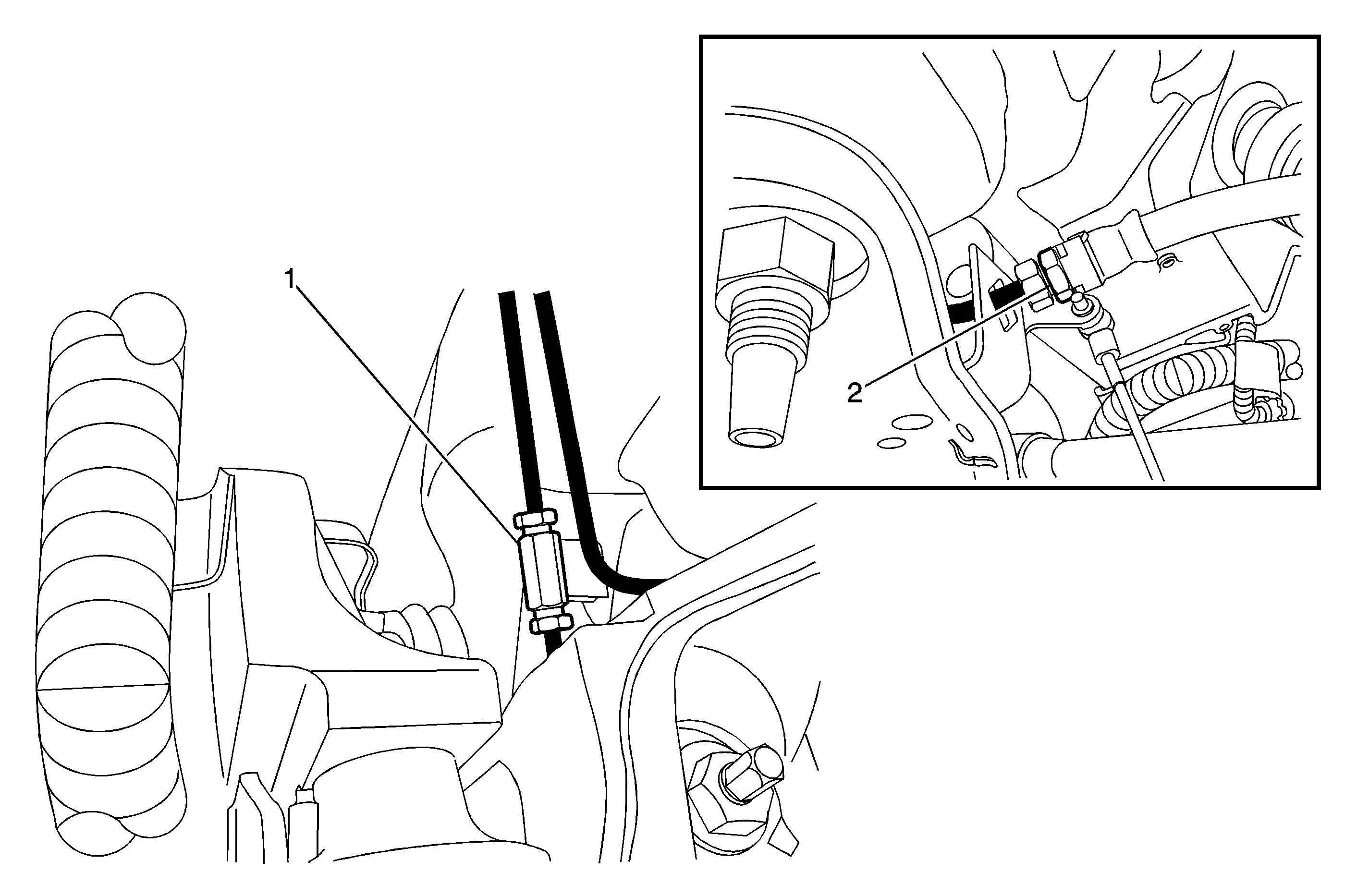
Tighten
Tighten fittings to 18 N·m(13 lb ft).
Tighten
Tighten the fittings to 18 N·m(13 lb ft).
Tighten
Tighten the fittings to 18 N·m(13 lb ft).
Important: When installing the bolts in the next step, the first bolt to be installed must go in the one ROUND locating hole in the panel. The remaining 35 bolts can then be installed in the SLOTTED holes.
Tighten
Tighten the bolts to 10 N·m(88 lb in).
Tighten
Tighten the bolts to 50 N·m(37 lb ft).
Tighten
Tighten the studs to 20 N·m(15 lb ft).
Tighten
Tighten the clamps to 44 N·m(32 lb ft).
Rear Brake Crossover Pipe Replacement -- Cadillac XLR and Chevrolet Corvette
- Raise the vehicle on a suitable hoist and support as necessary.
- Remove the exhaust pipe nuts (2) at the converters (5).
- Loosen the exhaust pipe to muffler band clamps (2,5).
- Remove the exhaust pipe hanger lower bolts (3).
- Slide the mufflers out from the rear hangers (1).
- Separate the exhaust pipes from the mufflers.
- Remove the exhaust pipes and mufflers.
- Remove the four nuts (4) attaching the transaxle/differential mount to the rear crossmember.
- Using a transmission jack under the transmission, carefully raise the differential assembly to gain access for removal of the crossover brake pipe.
- Disconnect the crossover brake pipe at the union (1) on the left side of the vehicle.
- Release the two retainers that attach the crossover pipe to the crossmember.
- Release the clips attaching the wiring harness to the crossmember.
- Remove the clip that attaches the right rear flexible brake hose and crossover pipe to the bracket.
- Disconnect the crossover brake pipe from the flexible brake hose.
- Remove the crossover brake pipe from the vehicle.
- Install the new crossover brake pipe to the vehicle.
- Connect crossover pipe to right rear flexible brake hose.
- Install the clip that attaches the right rear flexible brake hose and crossover pipe to the bracket.
- Connect the crossover brake pipe to the union on the left side of the vehicle.
- Attach the two crossover pipe to crossmember retainers.
- Attach the wiring harness to the crossmember with the clips.
- Lower the differential assembly.
- Install the four nuts that attach the transaxle/differential assembly mount to the crossmember.
- Position the mufflers over the rear axle.
- Connect the exhaust pipes to the mufflers and then to the converters.
- Connect the mufflers to the hangers.
- Install the exhaust pipe hanger lower bolts.
- Install the nuts on the converter studs.
- Position and install the exhaust pipe to muffler band clamps.
- Lower the vehicle.
- Bleed the brake system as necessary.






Tighten
Tighten to 18 N·m(13 lb ft).
Tighten
Tighten to 18 N·m(13 lb ft).
Tighten
Tighten the nuts to 50 N·m(37 lb ft).
Tighten
Tighten the bolts to 50 N·m(37 lb ft).
Tighten
Tighten the studs to 20 N·m(15 lb ft).
Tighten
Tighten to 44 N·m(32 lb ft).
Courtesy Transportation
The General Motors Courtesy Transportation Program is intended to minimize customer inconvenience when a vehicle requires a repair that is covered by the New Vehicle Limited Warranty. The availability of courtesy transportation to customers whose vehicles are within the warranty coverage period and involved in a product recall is very important in maintaining customer satisfaction. Dealers are to ensure that these customers understand that shuttle service or some other form of courtesy transportation is available and will be provided at no charge. Dealers should refer to the General Motors Service Policies and Procedures Manual for courtesy transportation guidelines.
Claim Information
Submit a Product Recall Claim with the information indicated below:
Repair Performed | Part Count | Part No. | Parts Allow | CC-FC | Labor Op | Labor Hours | Net Item |
|---|---|---|---|---|---|---|---|
Inspect brake pipes only (XLR & Corvette) (Inc. removing the boss) | 0 | N/A | * | MA-96 | V1255 | 0.4 | *** |
Add: Replace front section of rear pipes only (XLR) | 1 | -- | ** | 1.9 | |||
Add: Replace rear section of rear pipes only (XLR) | 1 | -- | ** | 1.6 | |||
Add: Replace crossover pipe only (XLR & Corvette) | 1 | -- | ** | 0.9 | |||
Add: Replace front & rear sections of rear pipes (XLR) | 2 | -- | ** | 2.0 | |||
Add: Replace front & rear sections of rear pipes & crossover pipe (XLR) | 3 | -- | ** | 2.3 | |||
Add: Replace front section of rear pipes & crossover pipe (XLR) | 2 | -- | ** | 2.2 | |||
Add: Replace rear section of rear pipes & crossover pipe (XLR) | 2 | -- | ** | 1.8 | |||
Courtesy Transportation | N/A | N/A | N/A | MA-96 | **** | N/A | ***** |
* The "Parts Allowance" should be the sum total of the current GMSPO Dealer net price plus applicable Mark-Up or Landed Cost Mark-Up (for Export) for the brake fluid needed to complete the repair. ** The "Parts Allowance" should be the sum total of the current GMSPO Dealer net price plus applicable Mark-Up or Landed Cost Mark-Up (for Export) for the brake pipe(s) needed to complete the repair. *** XLR ONLY -The amount identified in the "Net Item" column should represent the sum total of the current GMSPO Dealer net price plus applicable Mark-Up or Landed Cost Mark-Up (for Export) for cover (1 unit services 4 vehicles) needed to perform the required repairs, not to exceed $2.20 USD, $3.74 CAD. **** Submit courtesy transportation using normal labor operations for courtesy transportation as indicated in the GM Service Policies and Procedures Manual. ***** The amount identified in the "Net Item" column should represent the actual dollar amount for courtesy transportation. | |||||||
Note: Canadian dealers should refer to the Canadian distribution of the bulletin for detailed claim information.
Refer to the General Motors WINS Claims Processing Manual for details on Product Recall Claim Submission.
Customer Notification -- For US and Canada
General Motors will notify customers of this recall on their vehicle (see copy of customer letter included with this bulletin).
Customer Notification -- For IPC
Letters will be sent to known owners of record located within areas covered by the US National Traffic and Motor Vehicle Safety Act. For owners outside these areas, dealers should notify customers using the attached sample letter.
Dealer Recall Responsibility -- For US and IPC (US States, Territories, and Possessions)
The US National Traffic and Motor Vehicle Safety Act provides that each vehicle which is subject to a recall of this type must be adequately repaired within a reasonable time after the customer has tendered it for repair. A failure to repair within sixty days after tender of a vehicle is prima facie evidence of failure to repair within a reasonable time. If the condition is not adequately repaired within a reasonable time, the customer may be entitled to an identical or reasonably equivalent vehicle at no charge or to a refund of the purchase price less a reasonable allowance for depreciation. To avoid having to provide these burdensome remedies, every effort must be made to promptly schedule an appointment with each customer and to repair their vehicle as soon as possible. In the recall notification letters, customers are told how to contact the US National Highway Traffic Safety Administration if the recall is not completed within a reasonable time.
Dealer Recall Responsibility -- All
All unsold new vehicles in dealers' possession and subject to this recall MUST be held and inspected/repaired per the service procedure of this recall bulletin BEFORE customers take possession of these vehicles.
Dealers are to service all vehicles subject to this recall at no charge to customers, regardless of mileage, age of vehicle, or ownership, from this time forward.
Customers who have recently purchased vehicles sold from your vehicle inventory, and for which there is no customer information indicated on the dealer listing, are to be contacted by the dealer. Arrangements are to be made to make the required correction according to the instructions contained in this bulletin. A copy of the customer letter is provided in this bulletin for your use in contacting customers. Recall follow-up cards should not be used for this purpose, since the customer may not as yet have received the notification letter.
In summary, whenever a vehicle subject to this recall enters your vehicle inventory, or is in your dealership for service in the future, please take the steps necessary to be sure the recall correction has been made before selling or releasing the vehicle.
January 2005Dear General Motors Customer:
This notice is sent to you in accordance with the requirements of the National Traffic and Motor Vehicle Safety Act.
Reason For This Recall
General Motors has decided that a defect, which relates to motor vehicle safety, exists in certain 2004 and 2005 model year Cadillac XLR vehicles, and 2005 model year Chevrolet Corvette vehicles. The rear brake lines may contact other components or be affected by heat from them.
If contact occurs, the driver may hear a rattle noise. Over time, the contact could cause brake line wear-through resulting in a slow loss of brake fluid, which would appear as fluid spotting under the vehicle. On XLR vehicles, this could also create a visible puff of smoke when the brakes are applied. If enough fluid is lost, the performance of the rear brakes will be reduced, there would be an increase in brake pedal effort in order to achieve the desired braking, and the brake system warning light may illuminate on the instrument panel.
If the brake line on XLR vehicles is affected by heat, the fluid in the brake line could boil. The performance of the rear brakes will be reduced and there would be an increase in brake pedal effort in order to achieve the desired braking.
If this were to occur when stopping distance is limited, a crash could occur.
What Will Be Done
Your dealer will inspect, and reposition or secure if necessary, the rear brake lines to ensure that there is adequate clearance from other underbody components. On some vehicles, a machining tab on the rear differential housing may need to be removed to provide adequate clearance. The rear brake lines are to also be inspected and, if damaged, repaired. This service will be performed for you at no charge .
How Long Will The Repair Take?
This inspection will take approximately 25 minutes. If repairs are required, an additional 1 to 2 ½ hours will be needed. However, due to service scheduling requirements, your dealer may need your vehicle for a longer period of time.
Contacting Your Dealer
To limit any possible inconvenience, we recommend that you contact your dealer as soon as possible to schedule an appointment for this repair. By scheduling an appointment, your dealer can ensure that the necessary parts will be available on your scheduled appointment date. Should your dealer be unable to schedule a service date within a reasonable time, you should contact the appropriate Customer Assistance Center at the listed number below. The Customer Assistance Center’s hours of operation are from 8:00 AM to 11:00 PM, EST, Monday through Friday.
Division | Number | Text Telephones (TTY) |
|---|---|---|
Cadillac | 1-866-982-2339 | 1-800-833-2622 |
Chevrolet | 1-800-630-2438 | 1-800-833-2622 |
Puerto Rico - English | 1-800-496-9992 |
|
Puerto Rico - Español | 1-800-496-9993 |
|
Virgin Islands | 1-800-496-9994 |
|
Guam | 1-671-648-8650 |
|
If, after contacting the appropriate customer assistance center, you are still not satisfied that we have done our best to remedy this condition without charge and within a reasonable time, you may wish to write the Administrator, National Highway Traffic Safety Administration, 400 Seventh Street SW, Washington, DC 20590 or call 1-888-327-4236.
Customer Reply Form
The enclosed customer reply form identifies your vehicle. Presentation of this form to your dealer will assist in making the necessary correction in the shortest possible time. If you no longer own this vehicle, please let us know by completing the form and mailing it back to us.
Courtesy Transportation
If your vehicle is within the New Vehicle Limited Warranty your dealer may provide you with shuttle service or some other form of courtesy transportation while your vehicle is at the dealership for this repair. Please refer to your Owner’s Manual and your dealer for details on Courtesy Transportation.
My GMLink Online
This free online service offers vehicle and ownership related information and tools tailored to your specific vehicle. To join, visit www.mygmlink.com , and enter your vehicle's 17-character vehicle identification number (VIN) shown on the enclosed customer reply form to get the most personalized information for your vehicle.
Federal regulation requires that any vehicle lessor receiving this recall notice must forward a copy of this notice to the lessee within ten days.
We are sorry to cause you this inconvenience; however, we have taken this action in the interest of your safety and continued satisfaction with our products.
General Motors Corporation
Enclosure
04086
